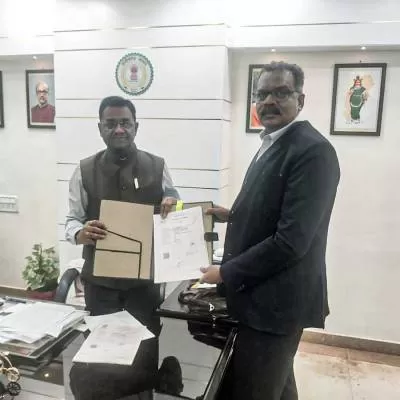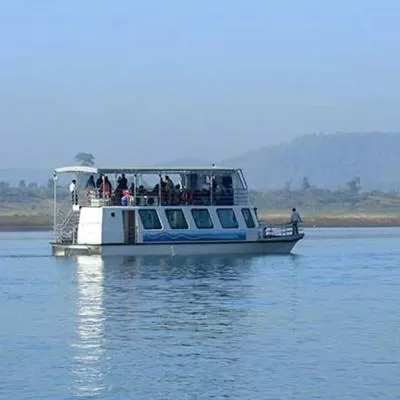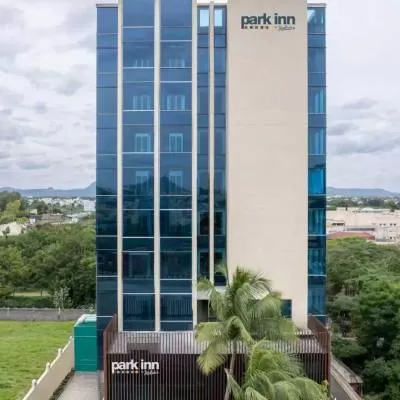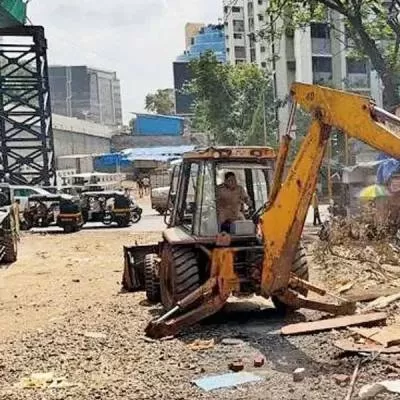Riding on infra push

Pick-up in infrastructure spending and construction activities is expected to drive the demand for tipper trucks in the coming years. The trend will be moving from basic economy trucks towards higher tonnage and value products. <span style="font-weight: bold;">EQUIPMENT INDIA</span> explores the new developments.
<p></p>
<p> The Indian truck market size in 2018 was around 7.9 lakh units, according to an ACG research report. The market is expected to reach 12 lakh units by 2030. The industry is shifting towards heavy segment due to better Total Cost of Ownership (TCO) and Return on Investment (ROI). According to the report, the 31T plus segment overtakes 25T segment. In this scenario, tipper truck OEMs are coming out with a lot of changes in design and features to improve productivity and efficiency that bring in operational economy to customers. </p>
<p> <span style="font-weight: bold;">On steady growth</span><br />
Government's continued focus on infrastructure development is driving the growth of construction activities in the country, which is a positive factor in the steady and consistent performance of tipper trucks market in the country. According to ICRA, pick-up in infrastructure spending and construction activity, especially in roads and highways, irrigation and affordable housing segment will continue to support demand for tipper trucks. "This trend has been visible during the current year as well. For instance, while cargo trucks have started seeing volume contraction for the past few months, the demand for tippers has remained resilient and been growing between 14-15 per cent per annum during the current fiscal," observes <span style="font-weight: bold;">Shamsher Dewan, Vice President and Sector Head - Corporate Ratings, ICRA.</span> </p>
<p> Indian construction and infrastructure industry is poised for rapid growth and transformation. In this scenario,<span style="font-weight: bold;"> Rajesh Kaul, Vice President & Product Line Head, M&HCV, Tata Motors,</span> highlights the trend for tipper trucks, "Medium and heavy commercial vehicles (trucks and tippers of 16 ton GVW and above category) has witnessed a year-on-year growth of 16 per cent vis-a-vis last year for the period April-January. Tipper segment has fuelled this growth with 61 per cent growth in volumes in the same period. Faster execution of the construction projects is one of the major reasons for this growth. Government spending has increased multifold on infrastructure and road development projects. Building of smart cities, railway projects, SEZ projects, port and port road development works, irrigation projects and other infrastructure projects are leading to growth for tippers. Mining tippers largely remain in the 6x4 category where we have been seeing a shift from 4x2 to 6x4 and in some cases to 8x4 configurations, whereas for surface movement applications, the shift is to 8x4, 8x2, 10x2 and tip trailers (up to 55T GCW)."</p>
<p><span style="font-weight: bold;">Rama Rao AS, EVP Sales, Marketing & Aftermarket, HD Trucks, VE Commercial Vehicles,</span> elaborates on the changing trend in tipper segment, "At present, the market is moving away from 6x2 to multi-axle vehicles (MAVs); 6x4 tippers are the most preferred category, capturing almost three-fourth of the total sales of dump trucks. Higher HP products are more in demand. However, recent norms on overloading restriction have pushed the demand for higher GVW (gross vehicle weight) (8x4 and 10x4/10x2) tippers. The smaller 16T tippers are preferred in hilly regions like Himachal Pradesh, Jammu & Kashmir and North East states." He further adds, "There is a need for more powerful trucks with latest technology and customers are preferring products with higher torque and HP to match the demand and meet the required levels of productivity, both in construction and mining."</p>
<p><span style="font-weight: bold;">Dinakar B, Vice President - Sales,</span> benefit of deploying better power-to-weight ratio trucks with latest technologies (automatic transmission, telematics, advance safety system, driver assist) and customers are getting into data analytics and advanced telematics for better fleet utilisation and stay ahead in market. Several segmental shifts taking place with the market moving from basic economy trucks to higher tonnage and value products (tractor, trailer and multi-axle trucks) for higher economics of operations and profitability among others. In terms of technologies, features such as telematics and fleet management technologies have started playing a crucial role towards mobility." </p>
<p>On the trend in mining segment, he says, "Mining activity takes place 24 hours a day, therefore trucks need to be robust and reliable, and run 24x7 on difficult terrains with heavy loads. To maximise truck utilisation, on-site service and part support is required to help the trucks running 24x7 at the mining sites. It is essential for customers to help the drivers achieve higher uptime and productivity, to meet project timelines and maximise profit."</p>
<p>According to Kaul, for construction and surface transport, customers are looking at higher capacity tippers with features like better mileage and enhanced driving comfort. </p>
<p>"Our Prima, Signa and LPK range are designed with powerful 300HP, 250HP and 230HP engines. Tipper ranges such as Tata PRIMA Lx 3130, PRIMA Lx 2530, LPK 2523, Prima Lx 2525.K and Tata Prima Lx 3125.K are best suited for off-road applications such as quarry and crushers. They are considered as tough performers that can successfully tackle every challenge in the heavy-duty operations offering above 60 per cent gradeability with crawler gear."</p>
<p>Dinakar elaborates, "We believe that suitability, flexibility and availability of the fleet are of paramount importance in both construction and mining applications. Both of these applications today demand different levels of productivity û while in the mining application, our trucks generally run for 20 to 21 hours a day, in the construction segment the utilisation is relatively lower. This tells us that there is a huge potential for improving the efficiency of the entire ecosystem and thus for lowering costs. With the government's focus on improving the road construction rate, we expect that the demand for using high productivity equipment will be the need for many contractors in the days to come." Another aspect that strongly influences choice of a product is the availability of the fleet. Dinakar adds, "In mining, Volvo trucks deliver an average availability of >90 per cent over 3-4 years of operation, i.e., with daily running of 20-21 hours. Our site-based service model ensures that we are at customer's doorstep to ensure that our availability percentages stay high and our customers are able to extract maximum output from our trucks. We have deployed similar service models even for the construction application."</p>
<p>Stepping up productivity needs better planning of projects, usage of higher capacity equipment, skilled manpower and an enabling ecosystem. "In terms of equipment, we are already witnessing a shift towards higher capacity machines û be it excavators, tippers, loaders or pavers in road construction. But there is a long way to go when it comes to improving overall productivity and efficiency in operation (e.g. working for 24 hours like in mining). At Volvo, we are committed to partner with our customers in improving their overall efficiency and productivity in operations by providing trucks which can carry more load per trip with less fuel, with better turnaround time, reduced overall fleet, improved safety at site and improved driver productivity compared to conventional solutions," Dinakar observes.</p>
<p> <span style="font-weight: bold;">Technologies gaining momentum </span><br />
When it comes to operational economy in tipper trucks, fuel efficiency and uptime play major roles. Kaul states, "Tata Construck tippers cater to the widest range of sectors. They have stood the test of time and delivered value to customers operating in varied applications." He adds on the safety and productivity perspective, "Tata Motors is among the leaders to deploy E-Viscous fan and FE Switch which help to increase the fuel efficiency and Electronic Stability Control (ESC) for select variants of PRIMA and SIGNA trucks. The advanced safety features such as Automatic Traction Control (ATC) and Hill Start Aid (HSA) will help prevent accidents and make roads much safer. The ESC technology will provide vehicle stability, and reduce accident risk, repair cost, and improve vehicle uptime. We have gone with the widely accepted and much advanced Selective Catalytic Reduction (SCR) technology to tackle the emissions to meet BS IV norms for our tippers of 180HP and above. This gives a better engine life and performance. Engine brakes in select range of tippers improve performance in downhill operations as well as add to the safety of our tippers." </p>
<p>On the other key features, Kaul adds, "Tata Motors offers tippers with comfortable cabin, proven powertrain, robust chassis, and better payload capacity. The chassis used in Tata tippers are powder coated (through cathode electrode deposition method), riveted and bolted. The frame used in Tata tippers are reinforced and have thicker dimensions to carry more load. Tata Prima tippers have scoop body made out of Hardox material, which increases the life and durability of the scoop body significantly. Our surface transport tippers for rated load movements have features for better fuel efficiency and options of lighter yet stronger bodies that can increase the effective payload of the vehicle and also the life of the body." </p>
<p>According to Rao, in India, telematics and fleet management have gained a lot of traction in the last few years. India is actually one of the fastest growing telematics markets and the installations in commercial vehicles is expected to grow to 9.3 per cent in 2023 ( from 2.4 per cent in 2016) as per a research conducted by Frost and Sullivan. One of the biggest benefits is also towards safety on the road. "These analytics help fleet owners keep track and get insights on driver behaviour and performance. Any damage or loss of trucks due to accidents and thefts are also alerted to the owner. The growth of telematics has been in the logistics and supply chain segment in domains such as information, navigation, safety, and remote diagnostics. Automotive companies are now integrated telematics to monitor vehicle performance and ensure vehicle and passenger security. The customers are able to detect the fuel consumed, driver behaviour and patters, which helps improve fuel efficiency." </p>
<p>Rao adds, "Manufacturers in India are now realising that telematics is not just about monitoring, but also about achieving transparency in business processes and efficiency. Remote diagnosis and assistance can help owners in getting improved uptime/turnaround time, while CV manufacturers will benefit by reduced warranty costs through preventive actions, and enhanced customer satisfaction." Building trucks has become more complex with more commitments, considerations, responsibilities and requirements. On the new features introduced, Dinakar elaborates, "Over the years, Volvo Trucks has introduced many new features in its trucks. A few major introductions have been the I-Shift transmission, Volvo engine brakes - which is Volvo patented technology, 10x4 dump trucks for mining, centralised lubrication system and Volvo's advanced telematics system - Dynafleet online. We have successfully tested many innovative technologies, like the Emergency braking system, Lane assist, Sleep detection system, Autonomous truck, platooning etc. These are under extensive testing and will be available in the future globally depending on the various market needs. Volvo has been actively working on the Autonomous truck technology. There have been many on road trials conducted as well."</p>
<p> <span style="font-weight: bold;">Intelligent technologies </span><br />
Use of intelligent technologies has started picking up in the Indian trucks market for the last few years only. Technologies such as telematics gained traction in the recent past with awareness about the growing technology. Rao elaborates, "Eicher has pioneered the use of intelligent technologies in its tippers to bring a significant improvement in quality, efficiency and productivity. Eicher is one of the first players to introduce the Fuel Coaching system in their Pro Series trucks which enables the driver to improve his driving and achieve better fuel efficiency. Eicher Live enables proactive maintenance of the truck. Together with the fully equipped Eicher service network, this ensures preventive and corrective maintenance of the truck, thus delivering superior uptime. Eicher Live services give the owner and our aftermarket teams a thorough view of vehicle performance, utilisation and uptime, so that the truck spends more time generating revenues. Coupled with features like Dynamic Service Reminders, allow to alter the truck's service plan." </p>
<p>He further adds on other features, "The innovative mileage booster+ technology, coupled with proven high-performance Volvo group EMS 3.0 makes the truck apt for optimum drivability, comfort and profitability. To address concerns of driver comfort and safety, the Eicher Pro series trucks are designed with an ergonomically designed ultramodern truck cabin for comfortable driving and higher driver efficiency. Mandatory fitment of Anti-Lock Braking System (ABS) for the domestic market has unlocked several opportunities for us. All trucks have the ABS system as part of safety requirements to help customers gain certain values in fuel efficiency."</p>
<p>Digital features play a pivotal role in the functioning and maintenance of the vehicles. It can help in increasing cost efficiency and better fleet utilisation through trip assignments and tracking of the vehicle. It also helps in improving the vehicle stability and driving accuracy, thereby preventing accidents.</p>
<p>Kaul elaborates on the digital features associated with Tata Motors trucks, "Top notch solutions are provided under the brand name of Tata Fleetman to help customers track and control vehicles anywhere in the country. It comprehends a variety of features like real-time monitoring, geo-fencing, trip review, alert reporting, and trip management. It also monitors any unauthorised vehicle movement and determines the exact location of the vehicles with a user-friendly graphical map. Customers have started adopting the Fleetman telematics system, and we have seen a positive feedback. Transporters can now understand their fleet utilisation, driving habits, live vehicle monitoring with the help of Fleetman. Today, Tata Motors boasts of the largest active fleet of over 100,000 vehicles plying on Indian roads enjoying the unmatched benefits of fleet telematics."</p>
<p>"With the help of Tata Fleetman, Tata Motors has established a proactive maintenance intervention process based on the real-time fault code transmission. Prior to this, such kind of futuristic technology was used only in the airlines maintenance operations," Kaul claims. </p>
<p>Dinakar is of the view that digital features in themselves are just data points and do not matter much to a customer. What makes a difference is analysing them and drawing out improvement actions. "Volvo's fleet management system, Dynafleet is one of the most advanced telematics systems that one could find in the market today. But what we have realised is that our customer may not have the bandwidth to sit and analyse the plethora of information that this system throws out, thus making it practically an unimpressive tool. So, we have a back-end team that works with the customer to identify the improvement areas and plug gaps. We even go a step further (if required) and conduct the necessary corrective actions if they fall in our domain of expertise to ensure that our customers get the best out of our products."</p>
<p>In the arena of support and maintenance, Volvo set a new benchmark in January 2019 with the inauguration of "Volvo Uptime Centre". Dinakar adds, "The primary objective of an uptime centre is to identify a potential breakdown before it happens and ensure that trucks that have come in for repairs move out without spending even a minute longer than required. With central monitoring centre in Bengaluru and regional centres planned in 10 key locations, we feel proud to bring this "industry first" concept to life in India. This initiative is expected to deliver a "delightful" customer experience and highlight our commitment of always prioritising our customer interest before anything."</p>
<p> <span style="font-weight: bold;">Preparing for BS VI </span><br />
Transitioning to BS VI norms will require significant changes in the electronics and technology, improvements in engine combustion and calibration. However, this would be an important move towards standardisation, enabling India to be at par with the European counterparts. The challenge can be met with adequate government support towards BS VI. How truck OEMs are preparing themselves for BS VI. Rao elaborates, "VECV is future ready to align with BS VI technology by April 1, 2020. Given VECV's strong foundation for its inbuilt capability and competence to produce Euro VI engines at the company's Pithampur plant to be exported to Volvo, Sweden, we are using this expertise towards April 2020 deadline. We also introduced India's first CNG BS VI engine solution much ahead of the industry norms. The development has given decent exposure to both VECV and ICAT for key areas for BS VI emission optimisation and testing. The successful completion of emission development and ICAT certification at this stage gives us a good competitive edge to launch robust and most feasible solutions for customer, much ahead of the deadline."</p>
<p>Kaul elaborates on features associated with Tata Motors trucks to meet the current emission norms, "Our current product portfolio of tippers above 150HP use the Selective Catalytic Reduction (SCR) technology compliant with BS IV emission norms. This is an advanced technology accepted throughout the world to achieve Euro IV norms. This has helped to deliver better fuel efficiency, higher life of engine with low maintenance and better performance of tippers, all of which have helped us in gaining market share and strengthening our leadership position in tipper segment."</p>
<p>At the same time, Tata Motors is working towards preparing the next level emission regulations. Kaul explains, "We have been consistently working towards upgrading our engines and vehicles to meet the required BS VI emission norms. The upgradation from BS IV to BS VI within three years is on such a vast range of medium and heavy commercial vehicles is a challenge. A challenge that demands not only pushing the technological advancements, but also calls for a turnaround of the infrastructure and facilities required for this development, which is highly capital-intensive with longer execution periods. We have set up the state-of-the-art æEmission Test Facility' at the Power Systems Engineering Division, in our Engineering & Research Centre, Pune. This facility serves as one of the crucial milestones for BS VI implementation. Adoption of SCR technology has made it comparatively easy for us to migrate to BS VI norms." He further adds, "While we are in advanced stage of BS VI migration, the BS VI vehicles can be introduced in future, once the requisite quality of fuel is made available across India for sustained emission performance." </p>
<p>BS VI in 2020 is going to be a big change in the way of working for many manufacturers and customers alike, according to Dinakar. "A change in the emission norms is not just a change but it must be viewed as a change in the entire ecosystem that supports key functions like manufacturing, operations and maintenance. BS VI will have a ripple effect on all of them. In Europe, Euro VI emission norms were affected about six years ago (considering implementation in 2020). The technology has come a long way and has stabilised over the years. However, for us quite a bit of customisation is called for to ensure that the applications in which our trucks work, they deliver productivity on par with the current levels despite all the changes. Volvo Trucks is geared up for this introduction in April 2020 and we look at this development with positivity and as an opportunity."</p>
<p> <span style="font-weight: bold;">Challenges </span><br />
While the market is progressing in terms of numbers and technologies, there are some key challenges that pause hurdles in the trucks market. These challenges are majorly related to skill development, parts availability, policy level uncertainties in mining, etc. Rao highlights, "Lack of skilled drivers is one major concern for the trucking industry. Eicher Pro Pilot is addressing this concern by imparting regular training. Eicher also runs driver training institutes and Driver Pragati Kendra. Most of the construction and mining sites are located in remote locations so delivering maximum uptime and availability of parts becomes a huge challenge." </p>
<p>Kaul elaborates on the challenges, "Implementation of GST, AC/blower norms, and implementation of rated load regime in select markets have all contributed to the changes in the operating economics as well as process and systems at the transporters' side. Constantly changing rules, although made for the betterment of the industry, are not easy to implement, especially where majority of tipper owners are not familiar with financing/IT/taxation processes. Increased Axle Norms (IAL) have brought some respite to transporters and made them keep their competitiveness. In the long run, we see these changes bringing betterment for the industry."</p>
<p>Looking at new trends in infrastructure sector, Kaul explains, "Most of the mega road and infra projects are going for a transparent tendering system. Majority of the market is still constituted by the retail and small size fleet operators who neither have proper financial records nor a flair for technology. Hence, there is a slow but steady rise in the organised players in the tipper market. It is now not uncommon to see more crusher owners forward integrating by buying tippers for the last leg deliveries of aggregates." </p>
<p>On the mining sector scenario, he adds, "Work conditions within the mines, exposure to dust and high SPM levels, long working hours and non-standardised and virtually absent HR policies keeps drivers a scarce resource. Availability and reliability of drivers is a big issue in the industry."</p>
<p>According to him, rising asset cost, rising interest rates, depreciating rupee, hardening crude oil prices, rise in the insurance rates as well as reluctance of some NBFCs from funding FTU customers in the recent past are some of the other issues facing the transporters.</p>
<p>Dinakar elaborates, "The biggest challenge we see is the prevalence of inefficiencies in the system that dissuades higher equipment utilisation. What many contractors and promoters do not realise is that the cost of this inefficiency creeps into their books on way or another and this cost is later transferred to the general public. Today as most customers in this segment do not demand higher efficiency manufacturers get away by delivering a sub-optimal level of performance and service. We all have read about how cost of logistics in India is almost 13-14 per cent of our GDP which is very high compared to most countries in the world. This must change and the government is doing quite a bit in this front to remove inefficiencies from the system. Till then, we will always have some short-term challenges like rush for discounting, freebies and funding but the real problem is much more intrinsic and difficult to solve."</p>
<p> <span style="font-weight: bold;">Outlook </span><br />
Te Indian CV industry has witnessed a greater preference for higher tonnage trucks over the past decade, according to Dewan. He adds, "The demand has gradually shifted from 16T to 25T and is further shifting in favour of 31T and 37T trucks over the years. In ICRA's view, this trend has been supported primarily by: superior economics of higher tonnage models, improving road infrastructure, dearth of experienced drivers and stricter implementation of overloading norms." </p>
<p>According to Kaul, a lot of construction and road projects which are underway or have been sanctioned are likely to give demand impetus. "Demand will be buoyant in the next fiscal year as well due to pre-buying, as the implementation of BS VI rules kicks in from 2020. We have seen this trend during earlier BS norm transitions and also seen similar buying in some other advanced economies like the US. Replacement demand is expected to be rubout. However, a lot more depends on a stable government getting elected at the Centre in the upcoming general elections. If this happens, we are all set for another long period of sustained growth. That's what we are hoping for," he adds.</p>
<p>Rao highlights, "We expect the boost in construction equipment and tippers to continue as we anticipate a lot of push on developmental projects in the coming year with an expected growth of 10 per cent. Further, demand for higher GVW tippers continues as there are segmental shifts taking place with the market moving from basic economy trucks to higher tonnage and value products (tractor, trailer and multi-axle trucks) for higher economics of operations and profitability among others." </p>
<p>Dinakar adds, "Latent customer demands from niche segments in mining and construction have been more challenging and complex with the pressure on stricter project execution time lines etc and from each project to project, needs are unique and different. This is translating into the demand for more reliable, highly productive and most efficient transport solutions consistently delivering profitability for customers. We see potential to grow our business by using the good image and reputation we have in mining to expand into new areas like construction and long haul. We have already made some headway in construction with some key customers, who have bagged some large projects. We know we are in the right place at the right time, and are all geared up for the industry."</p>
<p>Considering the amount of jobs in the pipeline for greenfield and brownfield projects in the country, tipper trucks will see more demand in the coming years at various infrastructure segments, be it roads, real estate, aggregates, mining or demolition. In spite of the short term challenges of meeting the next level emission regulations and introduction of new features to meet the demands of user industry, the prospects are bright for tipper trucks in the long term. </p>
<p> <span style="font-weight: bold;">Features in demand</span></p>
<ul>
<li>Better power-to-weight ratio.</li>
<li>Automatic transmission</li>
<li>Data analytics</li>
<li>Advanced telematics</li></ul>
<p> <span style="font-weight: bold;">TRENDS</span><br />
</p>
<ul>
<li>Demand moving from basic economy trucks to higher tonnage</li>
<li>Demand has gradually shifted from 16T to 25T and is further shifting in favour of 31T and 37T trucks over the years</li>
<li>Trucks and tippers of 16 tonne GVW and above category has witnessed a year-on-year growth of 16 per cent vis-a-vis last year for April-January</li>
<li>Mining tippers demand will remain in the 6x4 category</li>
<li>Smaller 16T tippers are preferred in hilly regions</li>
<li>Telematics markets and the installations in CVs to grow to 9.3 per cent in 2023 from 2.4 per cent in 2016</li></ul>
<p> <span style="font-weight: bold;">- Sudheer Vathiyath</span></p>













